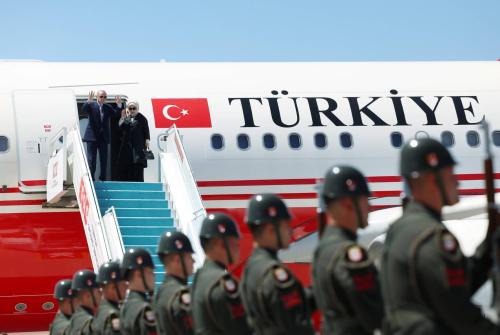The U.S. military will carry out a major modernization of its strategic nuclear forces in the 2020s.
It will cover all three legs of the strategic triad.
Much of the planned program makes sense. The long-range standoff (LRSO) — a new nuclear-armed cruise missile to outfit strategic bombers — does not.
The primary reason for the modernization program is that many US strategic weapons systems are aging out, and American policy is that, as long as there are nuclear weapons, the United States will maintain a safe, secure and robust nuclear deterrent.
The Ohio-class ballistic missile submarines will begin to hit the end of their service life in the late 2020s, and the Navy will need new submarines. Submarines and submarine-launched ballistic missiles (SLBMs) make up the most survivable leg of the triad, and they carry the bulk of deployed US strategic warheads.
The service life of the Minuteman III intercontinental ballistic missile (ICBM) runs out in 2030. The Air Force seeks a replacement ICBM. At a minimum, keeping an ICBM leg of the triad would require another life extension program for existing Minuteman III missiles.
As for the air-breathing leg of the triad, the Air Force wants to procure 80 to 100 B-21 bombers. Plans are shrouded in secrecy but reportedly will incorporate stealth features and advanced electronic warfare capabilities to allow the aircraft to penetrate contested air space. The Air Force is also modernizing the B61 nuclear gravity bomb for use on strategic bombers.
One can and should question the Pentagon’s desired numbers for these programs. That is especially the case given the projected costs of strategic modernization, which Pentagon officials openly admit they do not know how to fund.
It is not clear why the United States will need to replace 400 deployed ICBMs on a one-for-one basis, particularly as the Air Force several years ago was prepared to go down to 300. A force of 200-300 ICBMs would suffice and result in significant cost savings. Likewise, one can challenge the requirement for 12 new ballistic missile submarines, as opposed to nine or 10.
The biggest question, however, arises over the LRSO, with a projected cost of $20 billion to $30 billion. The Air Force originally developed nuclear-armed air-launched cruise missiles (ALCMs) in the 1970s because the B-52 — then the mainstay of the strategic bomber fleet — presented a big target for adversary radars. That would make it hard for the aircraft to penetrate air defenses. A B-52 armed with ALCMs could remain outside of radar range and release its cruise missiles.
The B-2, with its stealth features, was designed to restore a penetrating capability. The Air Force plans to use stealth and electronic warfare capabilities to give the B-21 a penetrating capability as well. If these bombers can defeat and penetrate air defenses, that makes the LRSO redundant. (Moreover, unlike in the 1970s, the Air Force today has very capable long-range conventionally armed cruise missiles that provide a standoff capability for bombers.)
If, on the other hand, the stealth of the B-21 will be compromised in the not-too-distant future, then one has to question the wisdom of spending $60 billion to $80 billion — and perhaps more — to procure the B-21. If we believe the B-21 would soon encounter problems penetrating air defenses, scrap that program. Buy instead modified Boeing 767s, a variant of which will serve as the Air Force’s new aerial tanker, and arm them with the LRSO.
The Air Force’s evident attachment to the B-21 suggests, however, that it believes that the aircraft will be able to defeat adversary air defenses for some time to come. That means that the LRSO would add little capability to the US strategic force mix.
If one were to argue for the redundant capability provided by the LRSO, the number of new ALCMs that the Pentagon proposes to purchase — 1,000 to 1,100 — is difficult to understand. Even allowing for extra cruise missiles for test purposes, the number seems excessively high.
In its 2010 annual report to Congress on implementation of the Strategic Offensive Arms Reduction Treaty (SORT), the State Department advised that, as of Dec. 31, 2009, the United States had 1,968 operationally deployed strategic nuclear warheads. That figure captured the actual number of nuclear warheads atop SLBMs and ICBMs plus the number of nuclear bombs and ALCMs at air bases for use by bombers.
On June 1, 2011, a State Department fact sheet showed the number of deployed US strategic warheads as 1,800 as of Feb. 5, 2011, when the New Strategic Arms Reduction Treaty (New START) went into force. A Dec. 1, 2011, fact sheet provided a more detailed breakdown of US strategic forces. It stated that, as of Sept. 1, 2011, the United States had 1,790 deployed strategic warheads and 125 deployed strategic bombers. Like SORT, New START counts each warhead on a deployed ballistic missile as a deployed warhead. But New START counts bomber weapons differently from SORT. New START attributes each deployed bomber as one warhead, regardless of the number that it can carry or the number of weapons that may be at bomber bases.
The 125 deployed bombers on Sept. 1, 2011, would have counted as 125 under New START’s deployed strategic warhead total. Reducing 1,790 by 125 yields 1,665 — the number of deployed warheads then on US SLBMs and ICBMs.
Comparing the SORT and New START numbers is a bit of an apples-and-oranges comparison, but it gives some idea of the number of bomber weapons at US strategic bomber bases. Unless there was a dramatic increase in the number of warheads on ICBMs and SLBMs between the end of 2009 and September 2011 — and there is no reason to think that there was — comparing SORT’s 1,968 figure (end of 2009) to the 1,665 deployed warheads on ICBMs and SLBMs (under New START counting rules in September 2011) suggests some 300 nuclear bombs and ALCMs were at bomber bases. The B-2s would have been armed with bombs, which indicates a maximum of 200-250 ALCMs. The Federation of American Scientists (FAS) also estimates that there are about 300 nuclear weapons at strategic bomber bases, of which 200 are nuclear-armed ALCMs. FAS believes an additional 375 ALCM airframes are held in reserve.
This comparison raises the question: Why would 1,000-1,100 ALCM airframes be needed to support a couple of hundred deployed ALCMs?
The United States should sensibly modernize its strategic deterrent, particularly in a time of tight defense budgets. The case for the LRSO is demonstrably weak, especially for the planned size of the program. The LRSO should be shelved.
This piece was originally published in Defense News.
The Brookings Institution is committed to quality, independence, and impact.
We are supported by a diverse array of funders. In line with our values and policies, each Brookings publication represents the sole views of its author(s).



Commentary
Op-edLong-range stand-off does not make sense, nor do its proposed numbers
May 26, 2016